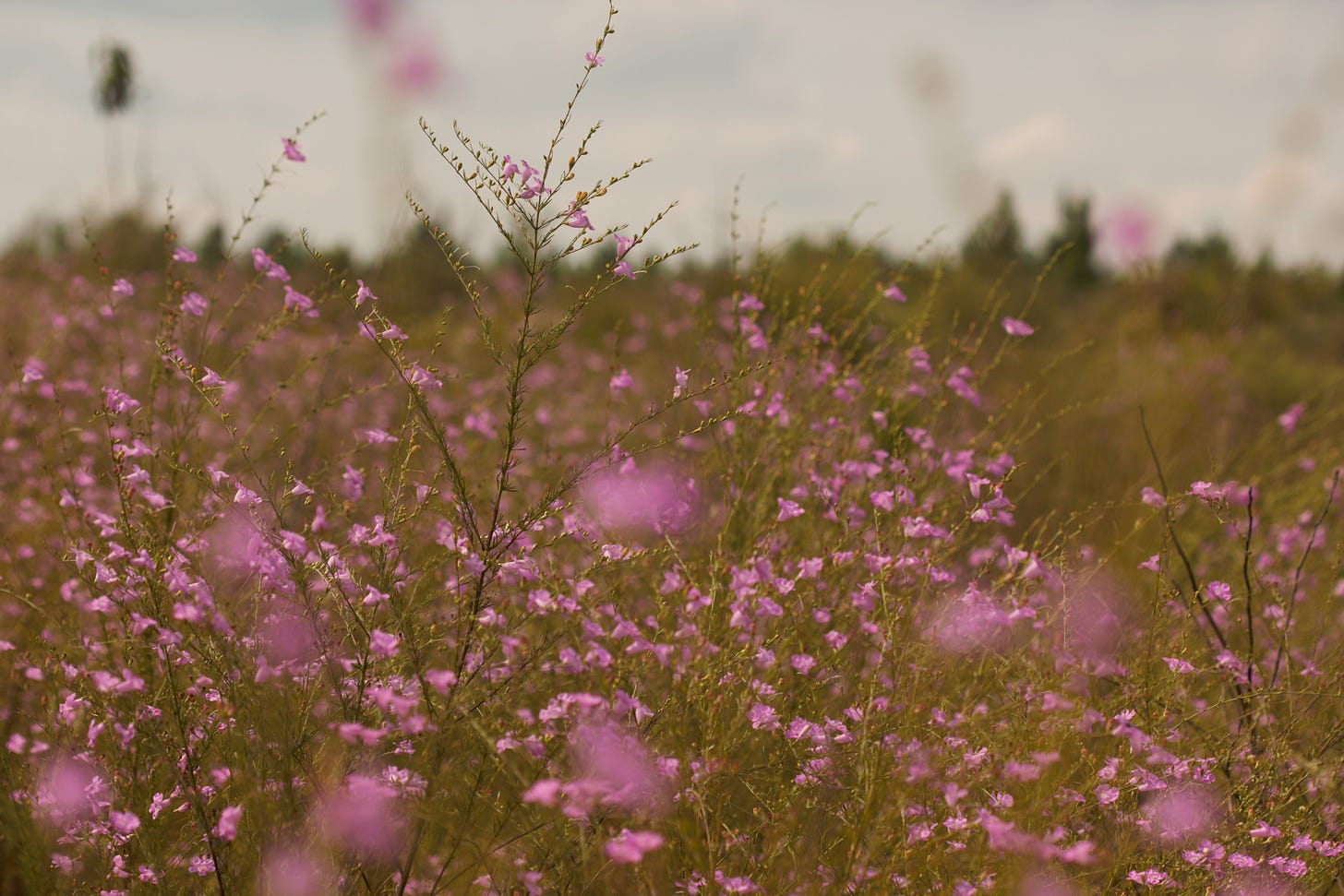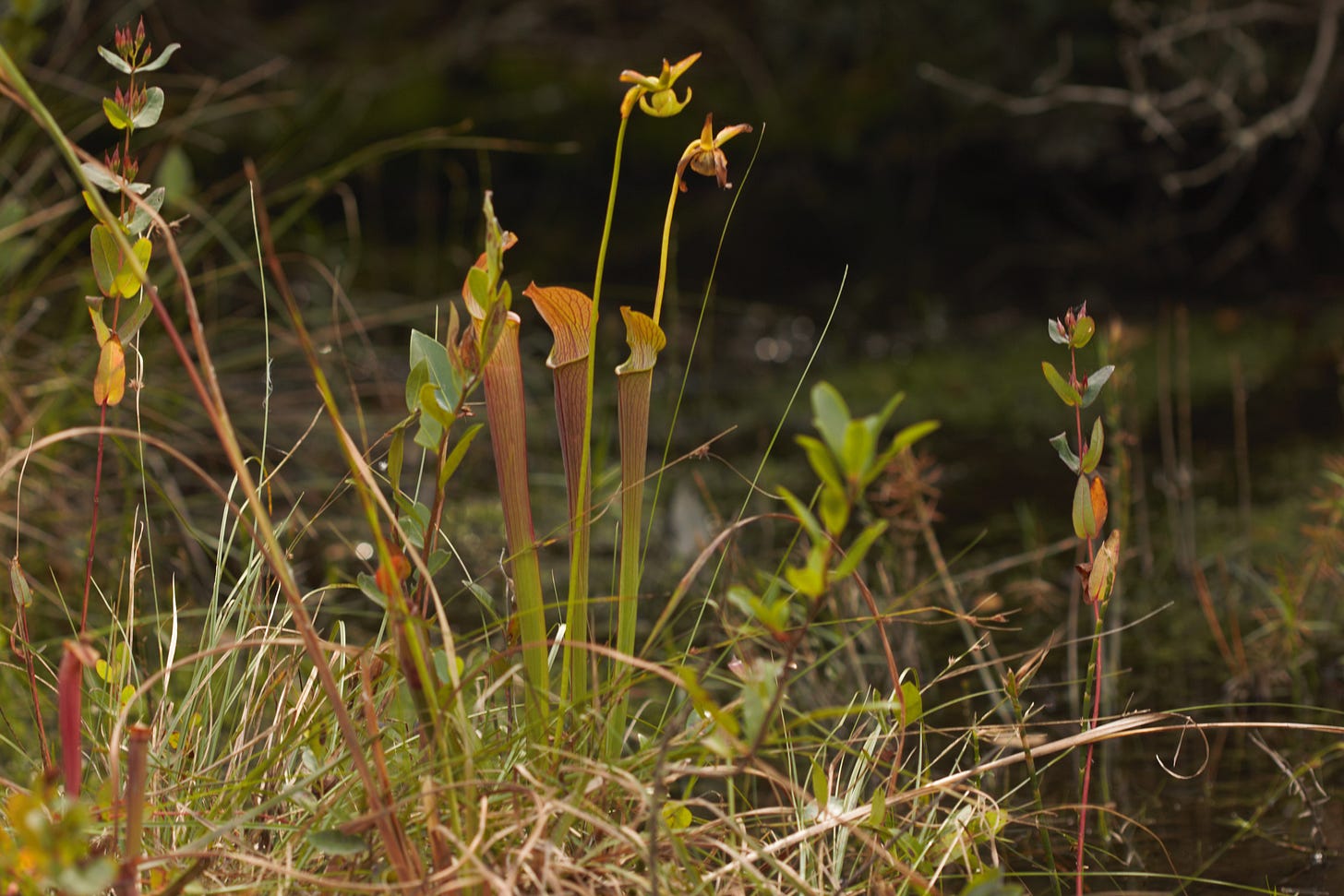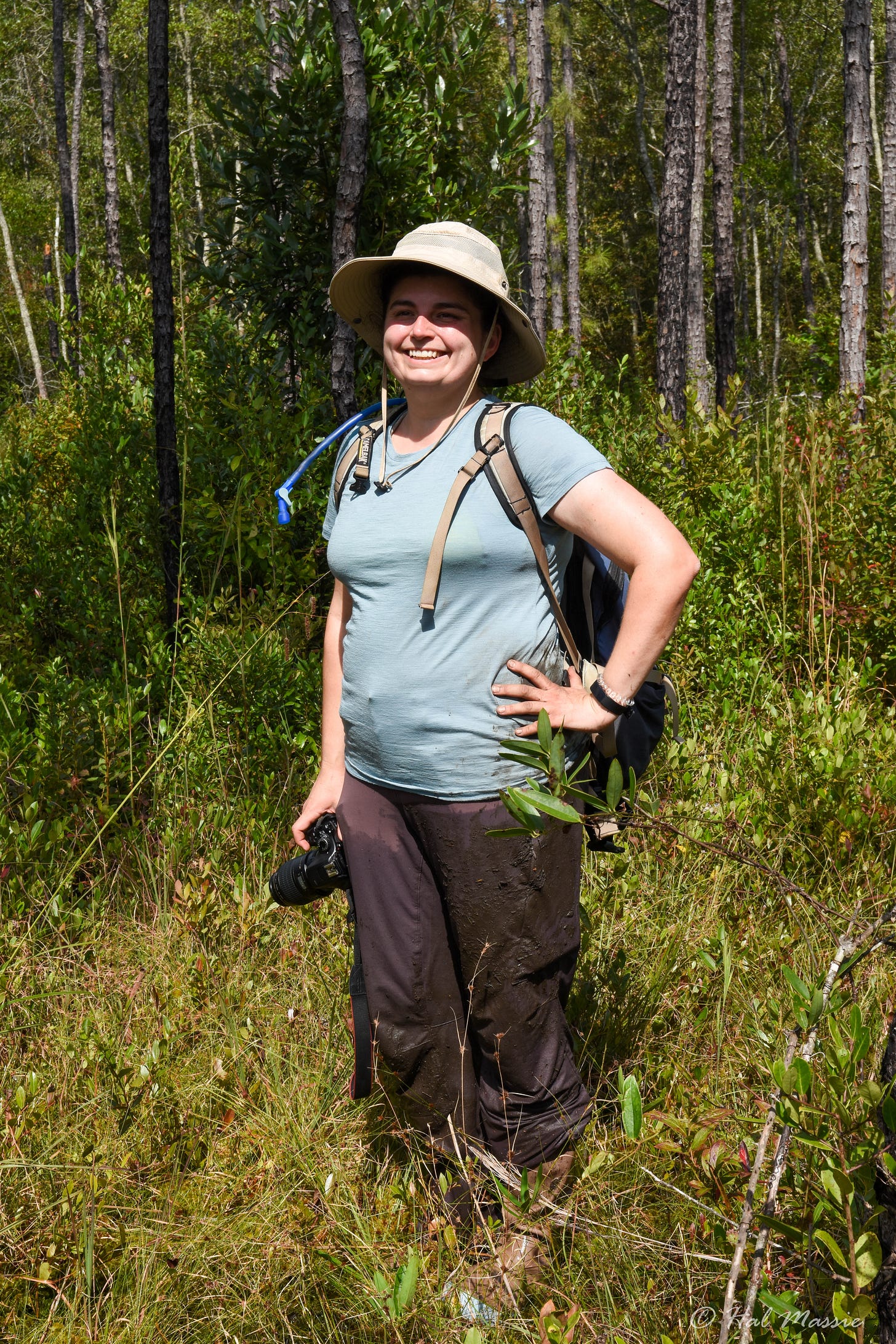The sun was hot and high overhead. The ground below was a tangle of bright green grass threaded among hot pink sundews, yellow-green sphagnum, and dark brown mud. Across the still, dark water of the bog, rising from a clump of green, were the blooms of a late-flowering red pitcherplant.
I wanted to photograph that plant. I stepped forward onto a grassy clump of what looked like solid ground. I felt my right leg sink. The rest of me soon followed, slowly yet inexorably, tumbling down into the grasping mud and dark water of Black Creek Bog. Somehow I held my camera safely above the surface.
"Sarah!" A voice called. Hal, the trip leader, continued. "What are you doing?"
"I fell," I replied.
I tried to pull my right leg up, but the bog held tight to my boot. I began to wonder if the only way out was to leave my boots behind — the knee-high rubber boots with the cute blue lining, my first pair of rubber boots that I was, on this trip, wearing for the first time. But I couldn't possibly walk all the way back to the truck with nothing but wet socks between me and the wild tangle of plants on the ground. This was not a place of well-worn trails, but of finding one's way in gaps between the branches of gallberry holly and fetterbush lyonia (two shrubs with thick, broad leaves.)
At some point — though I can't remember when — I had managed to photograph the pitcherplant. It is not even a good photo. This photo would not have been worth the loss of my boots:
"Here," said a voice behind me. Someone reached out to take my camera to safer ground. I handed it over.
Another arm reached out, grasped my hand, and pulled. With help, I was free of Black Creek Bog. I even had my boots, though they were flooded with water and heavy with mud. Back on solid, dry land, dark and dirty water drenched my pants and even the bottom half of my shirt. When I realized Hal was taking my photo, I laughed.
I laughed more, a couple of months later, when the photo appeared in the field trip report in the newsletter of the Georgia Botanical Society, along with a photo of me being pulled up and out of the mud, with a caption cheerfully stating that we were "exploring Black Creek Bog."
When I started writing again this past fall, I knew that the photo of myself that I wanted to accompany my work was the photo Hal took of me after I'd been pulled from the bog. And while I did not get the stunning pitcherplant photo that had led me onto unsteady ground and into the water, I got a much better photo from the experience.
A few months ago, when I tried to come up with a title for this Substack, I struggled, as I often do when trying to give anything a title. At the time, I answered the question, "Why do you want to write?" with some variation of the following: "I want to honor nature — my refuge — and the wild creatures I’ve encountered by recording my observations of them. I also want these records to serve as a temporary refuge made of words — for myself and for the reader, too."
I had recently read Diary of a Young Naturalist by Dara McAnulty, and I had loved it. What struck me about his descriptive prose was how it transported me to the places described. Even if I was reading indoors, in a place or time of stress, those words brought me almost as much peace as if I were outdoors, away from the pressure of deadlines and social expectations, away from the sensory hell of other people's smartphone speakers and car engines and leaf blowers — as if I were far from developed spaces, under a ceiling of sunlit tree leaves, a soft breeze weaving among those leaves and soothing me with its whispers, forming a duet with the rushing water of a nearby creek.
Like Dara McAnulty, I find peace in nature. When I could not be outside, descriptive writing like McAnulty's brought a similar peace.
I wanted to write to do the same for others. I wanted my words to build that "temporary refuge." So a title I considered for this Substack was, "Refuge Made of Words." My husband, a first reader whose opinion I value, called this title "kind of pretentious." He's right; it does not fit me. I am not always serious, and when I am exploring nature, it's not always meditative journeys through the woods, pausing to study a single beetle.1 Not infrequently, I fall in the mud, just like in my photo. And so the title, at least for now: Falling in a Bog.

Like Dara McAnulty, I am also autistic, though when I was of the age to be called a "young naturalist," I did not know this. It was not until July 2021 when I learned that I was, and had always been, autistic. Since then, I have reached for the words of other autistic writers as though they were a life raft (or the arm pulling me free of Black Creek Bog.) These words feel like a rare experience of reading something in my language, instead of a second language that will never make intuitive sense to me. Diary of a Young Naturalist was not only written in my language, but was also the first I had read in my language about my favorite topic: nature.
I wanted to read work by more autistic nature writers, and so I googled, "autistic nature writers." Google responds with, in big letters, "Dara McAnulty," as though there is only one autistic nature writer on Earth. I know there are more of us, but we seem to have a problem of representation. We need more neurodivergent nature writers!
I've been struggling with how I wanted to write about this identity, particularly when until three years ago, I wasn't even aware of it. But representation matters; there is a reason I read every late-diagnosed/late-identified autism memoir, particularly those written by middle-aged women. For all of these memoirs, all of the public figures who are openly autistic, misconceptions about autistic people abound. I am frequently reminded (and somehow shocked and disappointed each time) that many people believe we are flawed, diseased, and incapable of joy, love, or empathy — a problem to be solved, cured, or erased.
And so, this July (Disability Pride Month), three years after that life-changing discovery, I start this Substack: nature from a neurodivergent, autistic perspective. With my writing, I hope to celebrate the wild spaces and wildlife I encounter, bring readers a text version of the peace of being outdoors, provide other autistic readers with that same experience of "someone speaking our language," and for everyone, show the joy possible of experiencing the world as an autistic person. Even in a world not designed for our neurology.
The neurology that makes living in this world disabling is also what makes it joyful, because in the chaos of sights and sounds, small details stand out, like plants growing through cracks in a sidewalk, leafminers’ designs decorating their leaves, and insects perched on those leaves.
Our way of existing is not wrong; it is simply different. We are not an epidemic; we are a natural variation in humanity. We are as much a part of nature as the different kinds of insects and flowers celebrated throughout my writing.






I’m so happy I found you! And you’re in GA! At the age of 2, my grandson was diagnosed with ASD. I couldn’t understand it. At the time, my limited knowledge of autism consisted of Rain Man and Temple Grandin. My grandson’s diagnosis three years ago changed my life as I began researching autism. I probably need to write an entire essay about this. I too am drawn to what I’ve always referred to as “the odd ducks” because that’s what I am. I’ve never felt like I fit in because I’m just “too much”. I decided to take several extensive online tests for autism and I’m very much on the spectrum. It explains so many of the struggles I’ve been through in life and why nature has always been my sanctuary. Here in midlife, I’m embracing my eccentricities (that’s what my Granny always called them, who was also neurodivergent). I’m creating a life my grandson can thrive in here on our little farm and in the swamp. A place where his imagination can run wild and his creativity always has an outlet. A place that loves him just as he is. A sanctuary from a world that is “too much”. Thank you for being here, I love your posts.
Congratulations on your blog and your published essay! Your writing is amazing. What an incredible first post. I am not neurodivergent in a typical way, if there is such a thing. However, at age 71, I see a neurologist regularly for monitoring and brain scans. Cognition is declining, and sensitivities to sound and stimulation are great. Anxiety is high. Olfactory sense is mostly gone. Sometimes I have meltdowns. Thank you for sharing your talents and pespective.